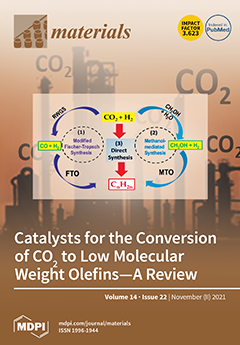Seven new low-temperature structures of 4-n-propylpiperazine derivatives, potential H3 receptor antagonists, have been determined by X-ray crystallography, with the following symmetry and unit cell parameters: 2-(4-propyl-piperazin-1-yl)oxazolo[4,5-c]pyridine (compound 1),
P-1, 5.9496 Å, 12.4570 Å, 12.8656 Å, 112.445°, 95.687°, 103.040°; 2-(4-propyl-piperazin-1-yl)thia-zolo[4,5-c]pyridine (compound 2),
I
[...] Read more.
Seven new low-temperature structures of 4-n-propylpiperazine derivatives, potential H3 receptor antagonists, have been determined by X-ray crystallography, with the following symmetry and unit cell parameters: 2-(4-propyl-piperazin-1-yl)oxazolo[4,5-c]pyridine (compound 1),
P-1, 5.9496 Å, 12.4570 Å, 12.8656 Å, 112.445°, 95.687°, 103.040°; 2-(4-propyl-piperazin-1-yl)thia-zolo[4,5-c]pyridine (compound 2),
I2/
a, 22.2087 Å, 7.5519 Å, 19.9225 Å, β = 92.368°; 2-(4-propyl-piperazin-1-yl)oxazolo[5,4-c]pyridine (compound 3),
C2/
c, 51.1351 Å, 9.36026 Å, 7.19352 Å, β = 93.882°; 2-(4-propyl-piperazin-1-yl)thiazolo[5,4-c]pyridine (compound 4),
Pbcn, 19.2189 Å, 20.6172 Å, 7.4439 Å; 2-(4-propylpiperazin-1-yl)[1,3]oxazolo[4,5-b]pyridine, hydrate (structure 5),
Pbca, 7.4967 Å, 12.2531 Å, 36.9527 Å; 2-(4-propylpiperazin-1-yl)[1,3]oxazolo[4,5-b]pyridine, first polymorph (structure 6),
P-1, 7.2634 Å, 11.1261 Å, 18.5460 Å, 80.561°, 80.848°, 76.840°; 2-(4-propylpiperazin-1-yl)[1,3]oxazolo[4,5-b]pyridine, second polymorph (structure 7),
P2
1, 8.10852 Å, 7.06025 Å, 12.41650 Å, β = 92.2991°. All the compounds crystallized out as hydrobromides. Oxazole structures show a much greater tendency to form twin crystals than thiazole structures. All the investigated structures display N—H···Br hydrogen bonding. (ADME) analysis, including the assessment of absorption, distribution, metabolism, and excretion, determined the physicochemical properties, pharmacokinetics, drug similarity, and bioavailability radar, and confirmed the usefulness of the compounds in question for pharmaceutical utility. This work is a continuation of the research searching for a new lead of non-imidazole histamine H3 receptor antagonists.
Full article






